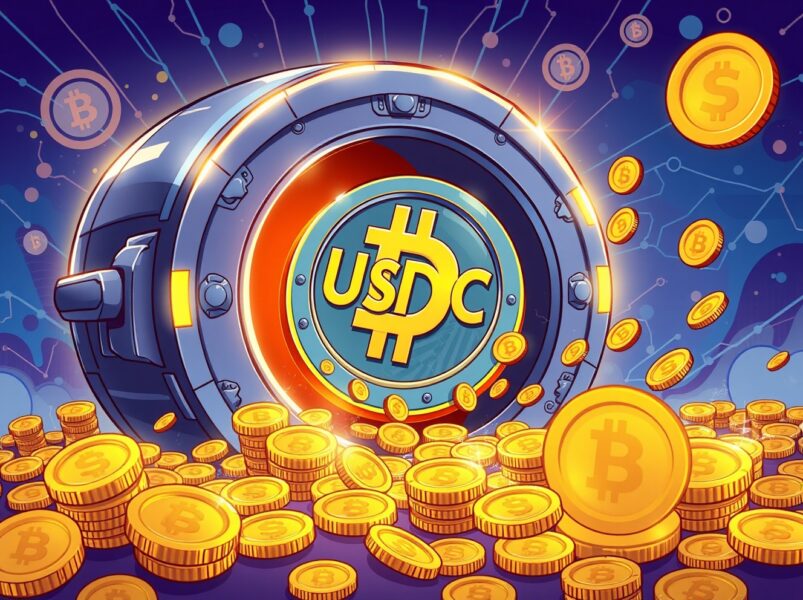USDC Minted: A Monumental Move for Stablecoin Stability
BitcoinWorld USDC Minted: A Monumental Move for Stablecoin Stability The cryptocurrency world is buzzing with significant news! According to a recent report from Whale Alert, a substantial 250 million USDC minted at the USDC Treasury has just been added to the digital asset landscape. This monumental injection of a major stablecoin is more than just a number; it signals important shifts and potential movements within the broader crypto market. For anyone tracking digital finance, understanding the implications of such a large-scale event is crucial. Let’s dive into what this means for stability, liquidity, and the future of decentralized finance. What Does 250 Million USDC Minted Really Mean? When we hear that 250 million USDC minted, it refers to the creation of new units of USD Coin (USDC). USDC is a stablecoin, meaning its value is pegged 1:1 to the US dollar. This makes it a crucial bridge between traditional finance and the volatile cryptocurrency market. The minting process typically occurs when an authorized entity, like Circle (the issuer of USDC), receives an equivalent amount of fiat currency (US dollars) and then issues new USDC tokens onto the blockchain. It’s essentially a digital representation of real-world money entering the crypto ecosystem. This process is vital for maintaining the stability and reliability of USDC. Every USDC token in circulation is theoretically backed by a corresponding dollar in reserves, ensuring its peg. The report from Whale Alert simply tracks these large movements on the blockchain, acting as a transparent monitor for significant transactions and creations of digital assets. So, while 250 million sounds like a huge sum, it reflects a direct inflow of capital or demand for a stable digital dollar. The Power of USDC Minted: Market Implications The creation of such a large amount of USDC minted often carries significant market implications. One primary effect is an increase in liquidity. More USDC means more stable capital available within the crypto ecosystem. This liquidity can be used for various purposes: Trading: Traders can use USDC to buy other cryptocurrencies, potentially driving up demand for assets like Bitcoin or Ethereum. Lending and Borrowing: Increased USDC supply can fuel decentralized finance (DeFi) protocols, making more capital available for lending and borrowing activities. On-ramps: It can signify that institutional investors or large-scale users are bringing more fiat currency into the crypto space, converting it into USDC for easier digital transactions. Moreover, a substantial minting event like this can sometimes be seen as a vote of confidence in the stablecoin’s utility and the broader crypto market. It suggests a demand for stable digital assets, which can be a positive indicator during times of market uncertainty or expansion. Navigating the Impact of USDC Minted on Crypto How might this fresh batch of USDC minted impact your crypto journey? While it’s not a direct price predictor for volatile assets, it can certainly influence market dynamics. For instance, if this newly minted USDC is primarily used to purchase other cryptocurrencies, we could see upward price pressure on those assets. Conversely, if it’s held as a stable store of value, it might indicate a cautious approach by investors seeking refuge from volatility. Consider these potential scenarios: Increased Trading Volume: Expect to see higher trading volumes on exchanges as this new capital moves around. DeFi Growth: DeFi platforms might experience an influx of liquidity, potentially leading to better interest rates for lenders or more accessible loans for borrowers. Institutional Interest: Large mints often coincide with institutional players entering or expanding their positions in the crypto market, using stablecoins as their entry point. Understanding these flows helps in making informed decisions, whether you are a trader, an investor, or simply curious about the crypto landscape. Why is More USDC Minted Now? The decision to have USDC minted in such large quantities is typically driven by market demand. There are several reasons why this might be happening: Growing Demand for Stablecoins: As the crypto market matures, more individuals and institutions are using stablecoins for transactions, remittances, and as a safe haven asset. Increased Institutional Adoption: Major financial institutions might be converting large sums of fiat into USDC to participate in DeFi or other blockchain-based financial services. Market Expansion: The overall growth of the crypto market, including new applications and use cases for blockchain technology, naturally increases the need for stable digital currency. Arbitrage Opportunities: Sometimes, large mints occur when there’s an arbitrage opportunity, where market participants can profit from slight price discrepancies between USDC and USD on different platforms. This minting event underscores the continuous evolution and integration of stablecoins into the global financial system. It highlights their role as essential infrastructure for digital economies. The recent report of 250 million USDC minted at the Treasury is a clear signal of significant activity within the stablecoin sector. This substantial injection of digital dollars into the ecosystem enhances liquidity, supports various DeFi applications, and reflects ongoing demand for stable assets in the volatile crypto market. As the digital economy continues to expand, stablecoins like USDC will undoubtedly play an even more critical role in bridging traditional finance with the innovative world of blockchain. Staying informed about these large-scale movements helps us understand the pulse of the market and anticipate future trends. Frequently Asked Questions (FAQs) Here are some common questions about USDC minting and stablecoins: What is USDC? USDC (USD Coin) is a type of cryptocurrency known as a stablecoin. Its value is pegged 1:1 to the US dollar, meaning one USDC is always intended to be worth one US dollar. This stability makes it a popular choice for transactions, trading, and as a digital store of value. Who mints USDC? USDC is issued by Circle, a regulated financial technology company, in partnership with Coinbase, through the Centre Consortium. They are responsible for ensuring that every USDC token is backed by an equivalent amount of US dollar reserves. Why is USDC minting important for the crypto market? Large USDC minting events indicate increased demand for stable digital assets. This often translates to higher liquidity in the crypto market, which can facilitate more trading, lending, and overall activity within decentralized finance (DeFi) ecosystems. It can also signal institutional interest. Are all stablecoins backed 1:1 like USDC? While many stablecoins aim for a 1:1 peg with fiat currencies, the backing mechanisms can vary. Some are collateralized by fiat reserves (like USDC), others by cryptocurrencies, and some are algorithmic (though these have faced challenges). USDC is known for its transparent, fiat-backed reserves. How can I track USDC minting events? Services like Whale Alert often report significant minting and burning events for major cryptocurrencies, including stablecoins like USDC. These reports are typically based on publicly available blockchain data, offering transparency into large-scale movements. We hope this article shed some light on the recent 250 million USDC minted event and its broader implications for the crypto market. If you found this information valuable, please consider sharing it with your network on social media. Your insights and shares help spread awareness and foster a more informed cryptocurrency community! To learn more about the latest crypto market trends, explore our article on key developments shaping stablecoin institutional adoption. This post USDC Minted: A Monumental Move for Stablecoin Stability first appeared on BitcoinWorld.
Coinstats2025/09/21 20:25 

